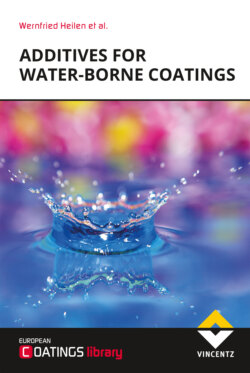Читать книгу Additives for Waterborne Coatings - et al. - Страница 5
На сайте Литреса книга снята с продажи.
Оглавление1Introduction
Wernfried Heilen
Water-borne coatings materials have very different properties from those of conventional solvent-based systems. The reason for this lies in the physical properties of water. The heat of evaporation of water is very high compared to that of many other solvents [1]. Consequently, air-drying systems dry more slowly at lower temperatures and/or higher relative humidity. Significantly more energy must be utilized in heat-curing systems.
Numerous solvents with different heats of evaporation and boiling points can be used to optimize drying and film-forming of solvent-based systems. In contrast, formulators of water-borne coatings have only a limited choice of solvents which can be used as water-soluble co-solvents.
As a strongly polar solvent, water has a comparatively high surface tension. Because of this and the make-up of the binder, which consists of incompletely dissociated polyelectrolytes or colloidal systems or emulsions based on various polymers, characteristic problems can occur during manufacture and application. This necessitates the development of specialist additives.
Essential for the manufacture of water-borne- as well as for solvent-based coatings systems are:
wetting and dispersing agents
Especially important in water-borne formulations are
defoamers as well as
rheology-modifying additives
As is the case with solvent-borne coatings, polymeric wetting and dispersing additives are used nowadays in the production of water-borne automotive and industrial coatings, while polyphosphates and salts of polyacrylic acids are used in the production of emulsion paints.
Aqueous pigment concentrates continue to be produced with the aid of fatty acid and fatty alcohol derivatives, and in addition of alkylphenol ethoxylates – although their ecotoxicity is controversial.
Fortunately, polymeric wetting and dispersing agents also find use instead of alkylphenol ethoxylates.
Foam-forming substances include emulsifiers used in the manufacture of water-based binders but also the wetting and dispersing agents mentioned above. Non-associative thickeners, such as those derived from cellulose, which have many hydrophilic segments in the molecules can also cause foam formation. Modern defoamers comprise a complex mixture of active substances, including mineral oils, polyether siloxanes, waxes, precipitated silicas, etc.
Synthetic as well as inorganic thickeners are used to control viscosity in all shear conditions, as well as properties such as flow, sagging, settling and storage stability. The polyurethane thickeners described in this book belong to the class of associative thickeners. The thickening function of these products is dependent on the system and is strongly influenced by certain constituents in the formulation.
The high surface tension of water can cause surface defects and inadequate adhesion on poorly-cleaned surfaces. Therefore, depending on the surface it is important to use
substrate wetting agents and
adhesion promoters
as additives or as co-binders in water-borne coatings systems. Deaerators are also indispensible in many formulations and particularly useful during airless application.
Flow and levelling additives based on polyether siloxanes or polyacrylates, which are also utilised in solvent-based coating systems, are only used in water-borne systems such as stoving enamels which contain large amounts of co-solvents.
Such additives are essential in many cases where surface tension gradients occur. Polyether siloxanes and waxes are also used because of positive characteristics such as reduction of friction.
Instead of rheological additives, low-solvent and solvent-free aqueous systems may contain gemini surfactants, which often also improve levelling thanks to effective substrate wetting.
Film-formers have already been discussed extensively in the literature and will therefore not be covered in any detail in this book, although their importance in water-based emulsions is undisputed.
To protect the applied water-borne coating from degradation the use of light absorbers, as well as of film preservatives, is absolutely essential.
Hydrophobing agents, which are mainly used in facade protection as co-binders or additives, are described as well.
The chapters of the book are also organised in the sequence set out above.
Finally, the production and use of a newly developed synthetic solid for preventing burnishing of applied emulsion paints are described.
1.1Literature
| [1] | Kittel, “Lehrbuch der Lacke und Beschichtungen”, Volume 3, Hirzel Verlag, Stuttgart-Leipzig 2001 |
Wernfried Heilen et al.: Additives for Water-borne Coatings
© Copyright 2021 by Vincentz Network, Hanover, Germany
